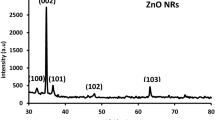Abstract
Vertically aligned TiO2 nanorods arrays were successfully synthesized on FTO glass by wet-chemical method. Based on polystyrene sulfate (PSS) functionalized TiO2 nanorods arrays, a sandwich-structured hybrid UV photodetector was fabricated. The photo-to-dark current ratio of the device increases by more than 3 orders of magnitude with typical case, while the dark current is about 10 nA at 1 V bias. The high photoresponse together with the low dark current could probably contribute a large photocurrent and low-power application. The high performance of the hybrid material and facile low-cost fabrication of the UV detector make the devices promising for large-area UV photodetection applications.
Similar content being viewed by others
References
Lin C, Song Y, Cao L X, et al. Effective photocatalysis of functional nanocomposites based on carbon and TiO2 nanoparticles. Nanoscale, 2013, 5: 4986–4992
O’Regan B, Gratzel M. A low-cost, high-efficiency solar cell based on dye-sensitized colloidal TiO2 films. Nature, 1991, 353: 737–740
Docampo P, Guldin S, Stefik M, et al. Control of solid-state dye-sensitized solar cell performance by block-copolymer-directed TiO2 synthesis. Adv Funct Mater, 2010, 20: 1787–1796
Li Y H, Gong J, He G H, et al. Fabrication of polyaniline/titanium dioxide composite nanofibers for gas sensing application. Mater Chem Phys, 2011, 129: 477–482
Zhang H F, Ruan S P, Li H L, et al. Schottky diode ultraviolet detector based on TiO2 nanowire array. IEEE Electron Dev Lett, 2012, 33: 83–85
Han Y G, Wu G, Wang M, et al. Hybrid ultraviolet photodetectors with high photosensitivity based on TiO2 nanorods array and polyfluorene. Appl Surf Sci, 2009, 256: 1530–1533
Han Y G, Wu G, Wang M, et al. High efficient UV-A photodetectors based on monodispersed ligand-capped TiO2 nanocrystals and polyfluorene hybrids. Polymer, 2010, 51: 3736–3743
Han Y G, Fan C C, Wu G, et al. Low-temperature solution processed utraviolet photodetector based on an ordered TiO2 nanorod array-polymer hybrid. J Phys Chem C, 2011, 115: 13438–13445
Xue H L, Kong X Z, Liu Z R. TiO2 based metal-semiconductor-metal ultraviolet photodetectors. Appl Phys Lett, 2007, 90: 201118
Kong X Z, Liu C X, Dong W, et al. Metal-semiconductor-metal TiO2 ultraviolet detectors with Ni electrodes. Appl Phys Lett, 2009, 94: 123502
Sakai N, Prasad G K, Ebina Y, et al. Layer-by-layer assembled TiO2 nanoparticle /PEDOT-PSS composite films for switching of electric conductivity in response to ultraviolet and visible Light. Chem Mater, 2006, 18: 3596–3598
La C S, Park M C, Kuang Q, et al. Giant enhancement in UV response of ZnO nanobelts by polymer surface-functionalization. J Am Chem Soc, 2007, 129: 12096–12097
Yu C, Park J. Thermal annealing synthesis of titanium-dioxide nanowirenanoparticle heterostructures. J Solid State Chem, 2010, 83: 2268–2273
Cheng G, Li Z H, Wang S J, et al. The unsaturated photocurrent controlled by two-dimensional barrier geometry of a single ZnO nanowire Schottky photodiode. Appl Phys Lett, 2008, 93: 123103
Kuo C Y, Tang W C, Gau C, et al. Ordered bulk heterojunction solar cells with vertically aligned TiO2 nanorods embedded in a conjugated polymer. Appl Phys Lett, 2008, 93: 033307
Liu B, Aydil E S. Growth of oriented single-crystalline rutile TiO2 nanorods on transparent conducting substrates for dye-sensitized solar cells. J Am Chem Soc, 2009, 131: 3985–3990
He X S, Hu C G, Feng B, et al. Vertically aligned TiO2 nanorod arrays as a steady light sensor. J Electrochem Soc, 2010, 157: J381–J385
Tsai T Y, Chang S J, Weng W Y, et al. A visible-blind TiO2 nanowire photodetector. J Electrochem Soc, 2012, 159: J132–J135
Author information
Authors and Affiliations
Corresponding author
Rights and permissions
About this article
Cite this article
Zheng, W., He, G., Li, X. et al. Hybrid UV photodetector with high photo-to-dark current ratio based on ordered TiO2 nanorod arrays and polystyrene sulfate. Sci. China Technol. Sci. 56, 2642–2645 (2013). https://doi.org/10.1007/s11431-013-5354-7
Received:
Accepted:
Published:
Issue Date:
DOI: https://doi.org/10.1007/s11431-013-5354-7




